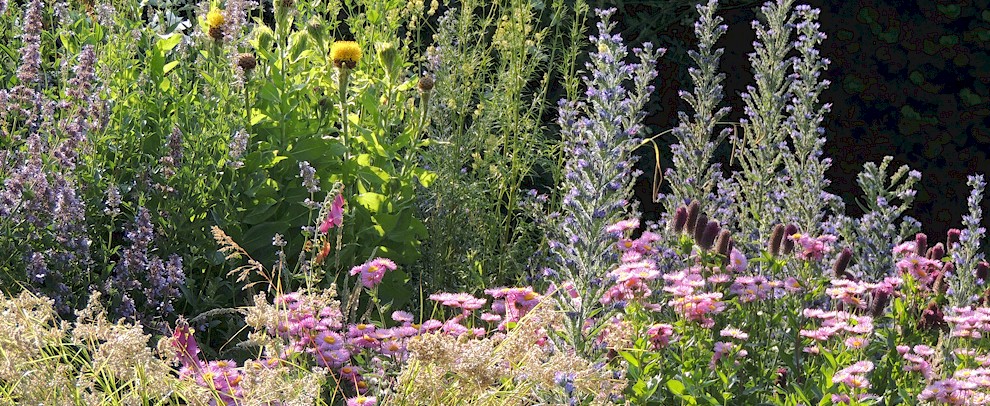|
All
invertebrates require food at some stage of their life cycle and bees, butterflies, bumblebees and
hoverflies as well as many other insect species use nectar and pollen
as a food source. A nectar border in the garden is a way of
encouraging wildlife in a quite unobtrusive way, as by choosing the
plants that insects like, you can encourage them to visit the garden,
without including habitats such as meadows. This may be particularly
valuable in a smaller garden, or one where a more conventional look is
required. It is possible to create a cottage garden feel, where every
plant is a good nectar or pollen source. You can also include in this
sort of border, plants with seeds to encourage birds. Insects will
also bring in birds such as warblers, robins, wrens and spotted
flycatchers, as well as hedgehogs and other small mammals. Many
plants have supplies of nectar, but they are not always accessible.
Many good nectar plants are old fashioned cottage garden types and
sometimes the best way to find them is in the garden of a friend or
neighbour. Garden centres tend to concentrate on the latest
introductions, with bigger and more showy flowers, and these are just
the kinds of plants that have little or no nectar.
How and where
to plant a nectar border
Insects detect
their nectar sources by colour and by scent. It therefore makes sense
to have your plant varieties in large groups if possible. A group of
three or five plants of the same type is more likely to be noticed by
passing insects than the odd plant of one type. It is also important
to choose plants that have single, not double flowers. Planting a
nectar border in full sun will ensure that the maximum number of
insects find it, as butterflies and bees particularly, like warm sunny
conditions. The majority of good nectar plants are hardy. The only
other consideration is to try to plant things that flower from the
very early spring, right through until the first frosts. Butterflies
especially will benefit from nectar from February to October.
How to
structure your border
A nectar border can be made in many different ways, but the most
common type is a mixed border with some shrubs at the back, herbaceous
plants and herbs in front, maybe some nectar and pollen rich annuals
in the spaces and one or two wildflowers as well. Bulbs can also be
included to bring colour in the spring. If you prefer, it is possible
to make a nectar border entirely with well chosen flowering shrubs,
mulched with bark - this is a very low maintenance way of encouraging
insects. In smaller gardens you may want to make a small border of
annual plants, varying the types each year, and this can be very
effective indeed. Basically a border can be designed to be what ever
you require - the only important consideration is the choice of
plants.
Choosing the
right plants
Most wildlife gardening books have lists of good nectar plants, but
beware! Much information is recycled from one book to another and
sometimes the suggestions are incorrect. One of the best ways of
choosing plants is to use your own eyes when you are visiting friends
or large gardens open to the public, and make a note of anything you
see that seems to be attracting insects. Even a visit to the garden
centre can provide useful information, (providing you go when plants
are in flower.) It is also worth remembering that nectar production
is dependant on the time of year, the weather, and even type of soil.
A plant that may be brilliant in a garden you visit may not be that
great with you. There is an element of trial and error. However,
having said that, here are a few suggestions of plants that will
definitely bring the butterflies, bees and birds to your border.
Plants for
butterflies
Most of us want to see more butterflies in the garden and there are
many good plants that will attract them. For the back of the border
try the paler forms of Buddleia. For the mid-border there are a good
number of smaller shrubs and herbaceous perennials which will fill the
spaces and provide colour over a long period. Many of our most useful
herbs are good butterfly plants, particularly hyssop, lavender and
marjoram. These, planted with sweet rocket (dames violet), honesty,
michaelmas daisies, coneflower (Echinacea), scabious and some annuals
such as cornflower will provide masses of summer colour, going into
autumn when the michaelmas daises come into their own. The front of
border plants could include bugle, sedum (ice plant, and the true
species is the only one worth planting), and phuopsis.
Plants for bees
Honey bees, bumble bees, leaf cutter bees, carder bees - there are
many different species of bee that visit the average garden. Lots of
plants will provide them with pollen and nectar but a few of the best
are listed here. For bumblebees the Buddleia globosa is very good for
the back of the border (this will not attract butterflies). Some of
the small shrubby herbs mentioned in the butterfly section are also
good, particularly hyssop, rosemary and lavender. Plants like
catmint, Echinops, yellow knapweed, Echium and dead nettle are all
excellent.
Plants for
hoverflies
Hoverflies are very useful in the garden because they and their larvae
eat aphids, so encouraging them is good biological control of these
pests. Many of the small open flowered annuals are good for them,
especially poached egg plant, baby blue eyes, Californian poppy and
shirley poppy.
Plants for
birds
Birds are quite fussy about the seeds they like but there are a few
plants that can be guaranteed to bring the finches in particular to
the garden. Try cornflowers, including the coloured varieties,
evening primrose, hardy geranium, teasel, and forget me not.
|

